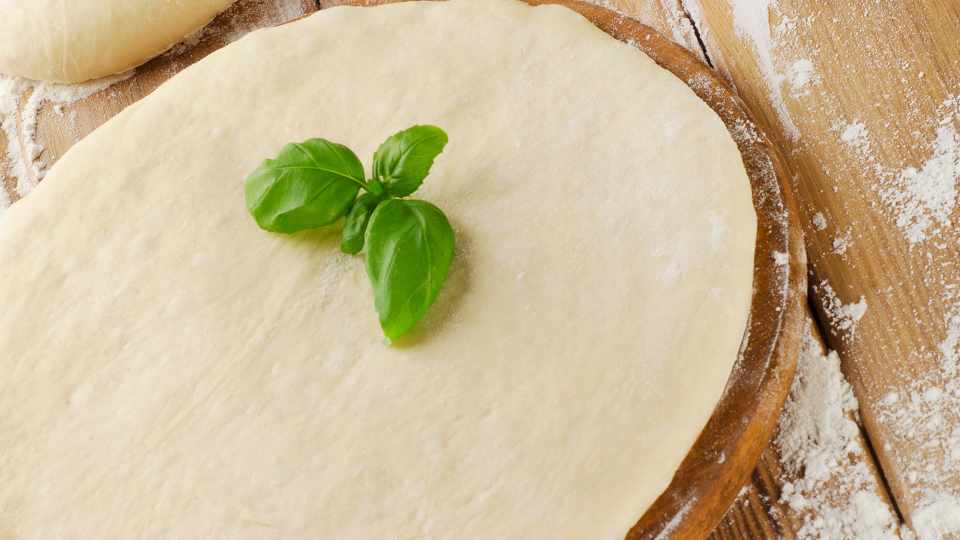How To Make Pizza Dough With Self-Rising Flour?
Tired of waiting for the dough to rise?
Now you can whip up a delicious pizza in no time using self-rising flour! This quick and easy pizza dough recipe doesn’t need yeast and requires just four ingredients: flour, baking powder, salt and oil.
And in this short guide, we will take a closer look at this simple yet amazingly flavorful recipe.
Easy Self-Rising Flour Pizza Dough Recipe
Ingredients And Measurements
The basic ingredients you will need are two cups of self-rising flour or all-purpose flour with added baking powder and salt, as well as three-quarters of a cup of cold water.
To make self-rising flour from all-purpose flour, combine 1¼ teaspoons of baking powder with ¼ teaspoon salt for every cup of all-purpose flour being used in the recipe.
Adding too much water will create a sticky or wet dough that is difficult to work with, so it’s important to add only enough liquid to achieve the desired consistency. For softer pizza dough, use slightly more water; for thinner pizzas go for less.
Additional herbs and spices are optional but can be added directly to the dry ingredients before combining them together with warm water until it forms a ball. This process yields enough dough to make one large thin-crust pizza in an oven preheated at 400°F (200°C).
Step-by-step Instructions
- – To make the dough, first, mix 1.5 cups of self-rising flour with 3/4 cup of tepid water and two tablespoons of vegetable oil in a large mixing bowl until combined into a smooth batter.
- – Knead the dough on a floured surface for 8 to 10 minutes.
- – Add extra flour as necessary to create an elastic ball which isn’t too sticky or wet.
- – Spray the inside of your mixing bowl with cooking spray and return the kneaded pizza dough to it, cover tightly with plastic wrap and leave either at room temperature for 90 minutes or longer if desired before making it into pizzas.
Advantages Of Using Self-Rising Flour For Pizza Dough

Time-saving And Convenient
Using self-rising flour for pizza dough is a great way to save time and make the process more convenient. This type of flour eliminates the need to wait for yeast or proofing, making preparation quick and easy.
Additionally, the blend of all-purpose flour, baking powder, and salt means that you don’t have to measure or mix any ingredients. All you have to do is combine them together in one bowl with some liquid.
The downside of using this type of ingredient for pizza dough is that it may not hold up as well as traditional recipes that rely on yeast. The texture won’t be quite as firm nor will it achieve a crispy bottom crust when baking without preheating an oven at a high temperature beforehand as other forms of pizzas require.
However, adding a little extra oil or butter can help give your dough strength if needed.
Light And Fluffy Texture
Self-rising flour is a combination of all-purpose flour and baking powder, making it the most convenient ingredient for no-yeast pizza dough recipes. Baking powder is an important raising agent as it produces carbon dioxide gas when mixed with water which causes the dough to rise.
This reaction results in a light and fluffy texture for homemade pizzas which makes them more appetizing than traditional crusts made with yeast. Moreover, self-rising flour requires much less time to prepare compared to those using yeast because there’s no need to wait for the dough to rise before cooking – saving valuable time when you’re in a rush! Additionally, using self-rising flour creates a milder flavour; due to its lighter texture and taste.
This contrasts with typical pizza dough recipes using yeast, which require hours of rising time resulting in stronger flavour derived from the fermentation process.
Variations And Tips For No-Yeast Self-Rising Flour Pizza Dough
Adding Herbs And Spices
Adding herbs and spices to the self-rising flour pizza dough is an excellent way to unlock a whole new range of flavour possibilities. Herbs can be added either dried or fresh for different flavour profiles, making it easier for you to customize your own unique pizzas.
For example, adding a tablespoon each of dried oregano and basil will add a herbal flavour that pairs deliciously with any type of topping, while a few tablespoons of freshly chopped parsley will give the dough brightness and complexity.
Other flavorful herbs like thyme, rosemary, dill weed, garlic powder (or flakes), red pepper flakes and chilli powder can also be infused into the pre-baked dough to create delicious savoury flavours in your pizza crust.
When using dry herbs in small quantities make sure not to overdo it as too much may lead to an overpowering bacon-like taste which many people find unpleasant.
The quantity you choose depends on personal preference but usually, 1½ teaspoons are enough for plenty of flavours when working with 4 cups (600 grams) of self-rising flour or equivalent all-purpose flour with baking powder.
Using Different Types Of Flour
Using different types of flour for pizza dough can result in a range of flavours, textures and overall eating experiences. All-purpose flour is the most widely available type of flour used in recipes like pizza dough, as it provides a great texture without any additives.
However, it doesn’t offer quite as much flavour or crunch compared to other types of flour such as bread flour or whole wheat flour.
Bread flour yields a crispier crust that’s full of flavour while whole wheat can add some nutty notes and a more complex taste. Whole wheat pizza will have an entirely unique character from traditional white crusts due to its heavier texture and denser crumb structure.
For those looking for healthier options for their dietary needs, whole wheat is the way to go! Additionally, adding semolina or cornmeal during the kneading process will give your crust increased structural support with added crunchy bits here and there which make every bite even more exciting!
Finally, if you’re using gluten-free flours such as almond meal or coconut flour be sure to also add xanthan gum since they don’t contain gluten-binding properties on their own.
Making Stuffed Crust Pizza
Making a stuffed crust pizza is easy to do with the no-yeast self-rising flour recipe. To form the crust and fill it, start by preheating your oven and combining the ingredients for the dough in a bowl.
Then, roll out the dough onto an oiled baking sheet or stone. Once that’s done, make sure you give your folded crust enough room when laying it on top of your rolled-out pizza base.
Remember, there needs to be roughly one inch between each fold to ensure even cooking! When filling the crust, you can use anything from cheese and garlic to bacon and pineapple slices, or whatever takes your fancy! Make sure that all edges are sealed securely so that none of the toppings spills through during baking.
Place into a preheated oven and bake for around 20 minutes or until cooked through.
Use A Pizza Stone Or Baking Tray
Using a pizza stone or baking tray when making pizzas with self-rising flour dough helps to produce a delicious and light crust. A pizza stone is a porous piece of ceramic that absorbs heat energy from the oven, creating an even cooking environment which yields a crispy, golden bottom crust while keeping the centre moist.
Baking trays are another great option if you don’t have access to one, however, they produce more browning on parts of the base directly touching them compared to using a pizza stone.
As mentioned before, this type of flour produces fluffy and light results – so it’s important not to overwork the batter when kneading it together as excess handling will result in dense crusts instead.
Experiment With Toppings And Seasonings
The key to a successful pizza is adding the perfect balance of flavours and textures. With just a few simple ingredients, creative experimentation can take your no-yeast self-rising flour pizza dough recipe from good to great.
Some classic combinations for toppings include pepperoni with fresh basil and shiitake mushrooms with parmesan cheese. Look for bolding flavours like anchovies or artichokes that contrast sweeter components like roasted red peppers or olives.
If you want to give the classic Margherita pizzas an extra kick, try adding porcini powder or pine nuts, while topping off cheesy pizzas with dried oregano.
To achieve even more satisfying results when cooking pizzas with a self-rising flour dough recipe, it’s important to preheat the oven to a high temperature so that the heat creates steam which helps raise and cook the dough evenly.
Preheat Oven To A High Temperature
Preheating the oven to a high temperature of 450°F is key when it comes to making pizza dough with self-rising flour. Not only does preheating bring out a delicious and golden brown crispy texture in your crust, but it also helps your pizza cook more evenly and quickly.
When the oven has reached its desired temperature, use either a preheated baking sheet or dish on which you’ll prepare the uncooked pizza dough before placing it into the oven.
Using either will help ensure an even distribution of heat all around during cooking time, thus resulting in a delicious crunchy outcome! For optimal flavour addition, try using a pre-seasoned pizza stone (that’s also been heated) for that classic brick-oven cooked taste as well as give extra life to crispier toppings such as olives and peppers.
Gluten-free And Vegan Options
Making pizza dough from self-rising flour that is both vegan and gluten-free is quick, easy, and delicious. Self-rising flour contains leavening agents so there’s no need for yeast or kneading! All you have to do is mix the ingredients together and roll it out.
Popular substitutions for traditional dairy products in the equation include nut milk (almond) for cream cheese, olive oil instead of butter, and ground flaxseed as an egg replacer.
You can also substitute wheat flour with non-wheat varieties such as chickpea or quinoa flour, teff flour which offers a dense yet chewy texture to the crust, rice four which makes a crunchy product perfect for thin-crust pizzas; or even coconut flour giving it dense but airy characteristics that work best when cooked on low heat.
To further enhance your vegan pizza creations adding herbs and spices like basil, oregano, and garlic powder is always recommended.
Conclusion
Self-rising flour pizza dough is a fast, simple, and delicious way to bake homemade pizzas without the need for yeast. The recipe only requires four basic ingredients – flour, baking powder, salt, and oil – making it incredibly easy to prepare a delicious pizza in just minutes.
Not only can other herbs and spices be added to suit personal tastes but the crust can also be stuffed with cheese or vegetables if desired. Plus this type of dough is beneficial for those following diets such as vegan or gluten-free as no animal products are included within the recipe and it does not require wheat-based flour either.






